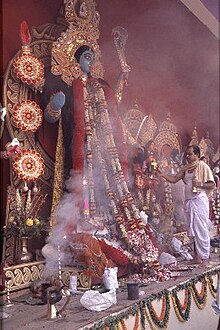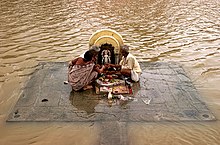Puja (Hinduism)

Puja ( Sanskrit , f., पूजा, pūjā, [ puːʤɑː ]) means something like "worship" or "honor". In Hinduism, the puja is ideally a daily practiced ritual and is one of the most important components of everyday religious life. A puja in Buddhism is done in a different way.
procedure
In principle, Hindu pujas can take place anywhere, in your own house and yard as well as in temples or in nature. In Hinduism, much of the religious practice takes place in the home. This includes the daily puja. The object of worship is the divine in a statue made of metal or other materials or even just from a colorful paper picture. Often the focus of the action is not the personal representation, but an emblem, such as B. a lingam or a trident for Shiva . The worship of the divine in certain plants, such as tulsi (Indian basil), or simply in a jug of water is also very common .
The 14 rituals are a Brahmin tradition, consisting of the following regionally different sequences:
- The deity is asked with mantras to be present in the image.
- A seat is symbolically offered
- and like a distinguished guest one offers the deity water to cleanse the feet,
- of the face and hands
- as well as for rinsing the mouth.
- Then it is tied with the sacred cord and adorned.
- She is dabbed with fragrant sandalwood paste ,
- and flowers are offered to her
- as well as incense sticks
- and a burning light with clarified butter (Dipa or Aarti ).
- Then you will be a victim dining purposed
- and then betel served.
- Finally the gifts are handed over ,
- and the ritual ends with the deity walking around in awe.
It is not the image or emblem itself that is the object of veneration, but the ultimate formless highest in it. But God is not only thought of outside: In a short meditation, the priest imagines the divine as being present in the heart, either personally or in symbol. In some pujas, a flower held in front of the heart is the outward sign of its presence. The priest holds the flower under his nose and imagines how the divine passes from the heart through the breath to it, and then places it in front of the image on the altar. Another possibility is to “give life” in a Shakti- Puja, the worship service in honor of the goddess: With a small tuft of grass and a few grains of uncooked rice in his fingers, which have to assume a very specific position, a mudra , the priest touches the heart area of the statue or the image. In addition, he says prescribed prayers which make the Murti (idol, statue of a god) "alive" and through which the goddess is then thought to be actually present.
Formal prayers and mudras (ritual hand positions) always accompany the external activities and only then does the event take effect. The ritual language for the priest is Sanskrit. Pujas are described in the Vedas as well as in the Puranas .
Those who cannot afford the 16 services described above are limited to sacrificing incense , candy and flowers. The daily domestic puja is also shorter and can be limited to these three objects. The light circle ceremony, arati, is common: the objects are waved in front of the altar while praying to the sound of a small bell. Arati is performed twice a day (ideally) by men as well as women. In these domestic pujas, Sanskrit, but also the respective national language, can be spoken. On holidays or special occasions such as house dedications, weddings or other Hindu sacraments , a priest can come to the house on request.
From the outside, the principle is to show honor to God as your highest guest. A wide variety of food is offered as an offering, both cooked and uncooked (which must be absolutely pure, vegetarian - without eggs, onions or garlic), fruits, milk, yoghurt, clarified butter and honey. The believers then consume the sacrificial foods as prasad . The priest ends the ritual with a formal farewell - outwardly recognizable when he gently moves the image back and forth.
Fire prayer
An important form of puja is the fire prayer - called Agni Puja, Jaggya or Homa, when the divine is worshiped in its flame form, the Agni . In Vedic times it was probably the most important sacrificial ritual. This form can still be found today on certain occasions, especially when it comes to purification ceremonies such as the inauguration of objects, as a ritual in the Hindu sacraments and as part of Shaktipujas .
The priest lights the firewood with prayer, which depending on the spatial conditions can be small and in a special copper bowl or large outdoors. It is bordered by stones. Little by little, with a spoon, he adds melted butter, one hundred and eight leaves of the “sacred” bel tree and certain seeds that keep the fire and are sacrifices at the same time. Flowers, incense sticks and small pieces of the sacrificial food are also thrown in and a butter lamp is waved. During ritual initiations or purifications, the flames are then carried through all rooms in a blessing. Finally, those present bless each other by running both hands over the flames and then over the forehead and crown of the head. With some ashes mixed with red powder, the priest places a blessing point on each forehead and speaks blessing words: "This sign give you peace!"
There are also different versions for fire pujas.
